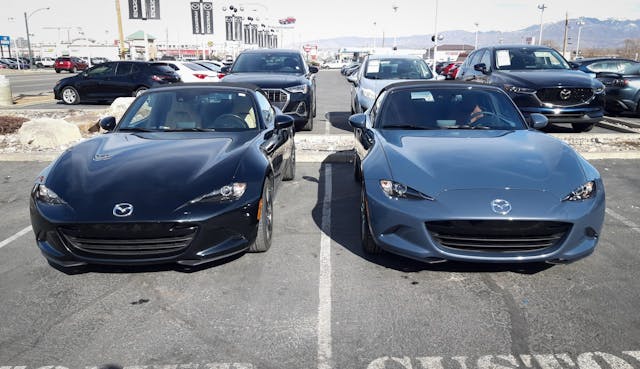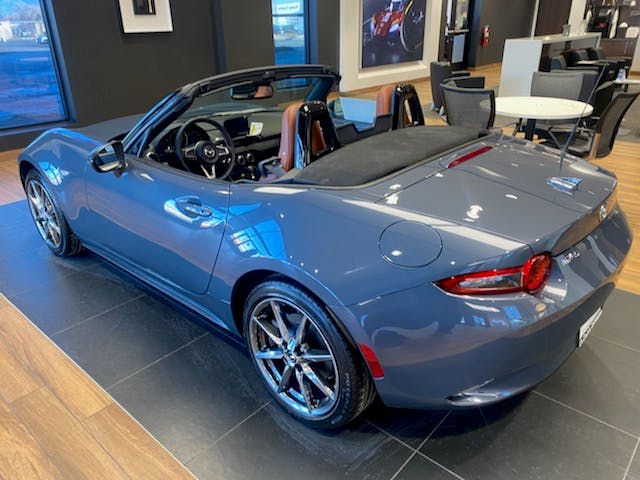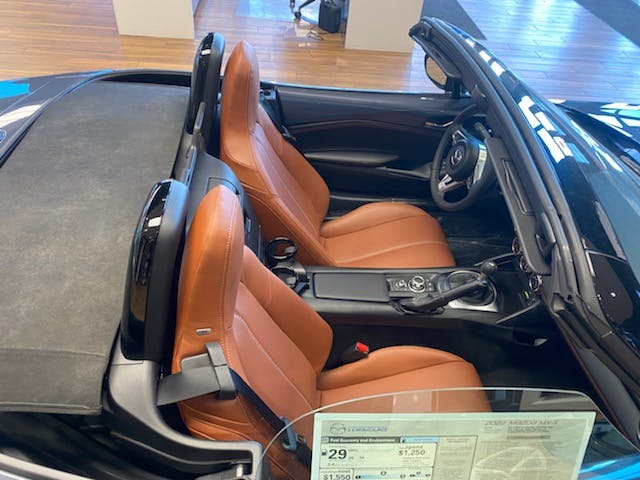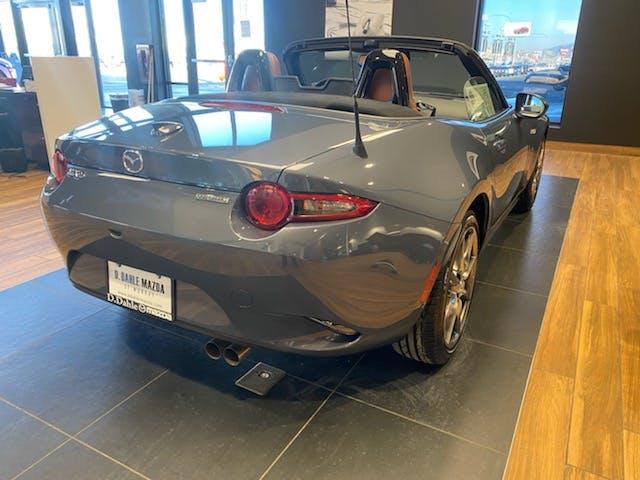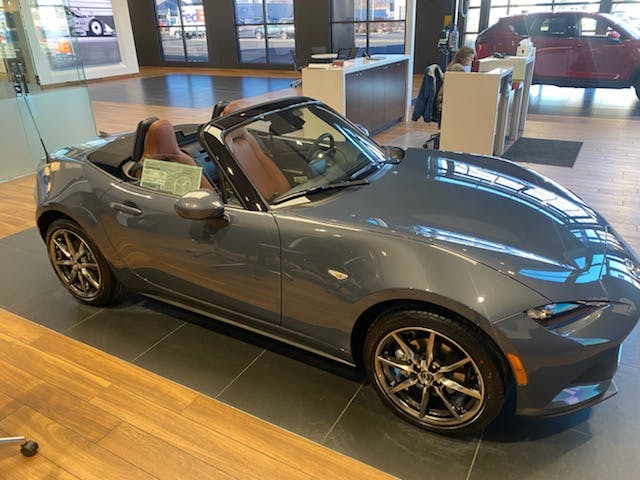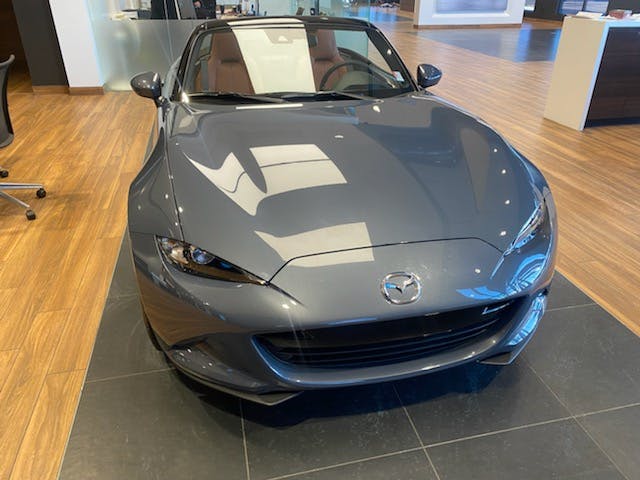Media | Articles
Rate vs. Radius: Our tame fighter pilot considers the consequences of a Miata trade
Cruising the interstate last weekend in our 2006 Lexus LX470, our 2016 Miata on a rented, double-axle car trailer behind us, I had just crested a small rise when a flash of movement from the right edge of my peripheral vision caught my attention. I turned my head and was surprised to see a steel wheel bouncing Free-Willy-style alongside me. As it bounded down the freeway, its trajectory took it alternately above and below my passenger-side door window; I struggled to visually identify the rim in the fleeting moments I could see it to determine if it belonged to my rented trailer. But I’m getting ahead of myself. Let’s go back a few months… and go up a few thousand feet
“Shoot! SHOOT!” came the imperative from the instructor sitting in the backseat of my fighter jet. I’ll admit, my spidey sense was indicating that something wasn’t entirely right with the nighttime aerial combat training scenario I was in, namely that I wasn’t convinced my radar was locked onto the guy I was supposed to target, but with such forceful commands bellowing out over the intercom, I acquiesced to his request and pushed the red pickle button and “launched” the radar-guided missile towards my foe.
(In training scenarios such as these, I direct my aircraft to pretend various weapons are loaded on the jet and I’ll get all the same symbology I would have if I were carrying and employing actual weapons. That includes pre-launch as well as post-launch cues. In this instance, pushing the “pickle button” made the jet think I had fired a missile, which I hadn’t actually done, and it displayed all the appropriate symbology.)
As I began my post-launch maneuvering, with Night Vision Goggles (NVGs) pulling on my helmet and neck under the g-forces, my instructor, so domineering in his commands a moment earlier, declared, “Duuuuude, you just shot lead!” Pronounced “leed”, not “led”. In other words, he was saying I had just shot a missile at my flight lead – not my desired “enemy”. That missile was sure to “kill” my flight lead and it was all my fault. Aside from clearly not wanting to shoot my buddies, the aforementioned instructor excluded, the cost of a same-side kill in training is a keg for the squadron bar. The associated public ridicule and shaming, combined with a lightened wallet, means that the undesirability of committing fratricide is generally a lesson learned just once.
The Wright Brothers’ first flight was on 17 December 1903. Less than eleven years later, in August of 1914 during the Battle of Cer, pilots began shooting at each other. The race to load aircraft with an ever-increasing array of sophisticated weapons began then, and has continued unabated ever since. As John H. Horatio wrote in his poem Red Baron’s Flying Circus, fighter pilots want to “See the smoke and flames, pluming away from my enemy’s plane, as its tail falls away…”
Marketplace
Buy and sell classics with confidence
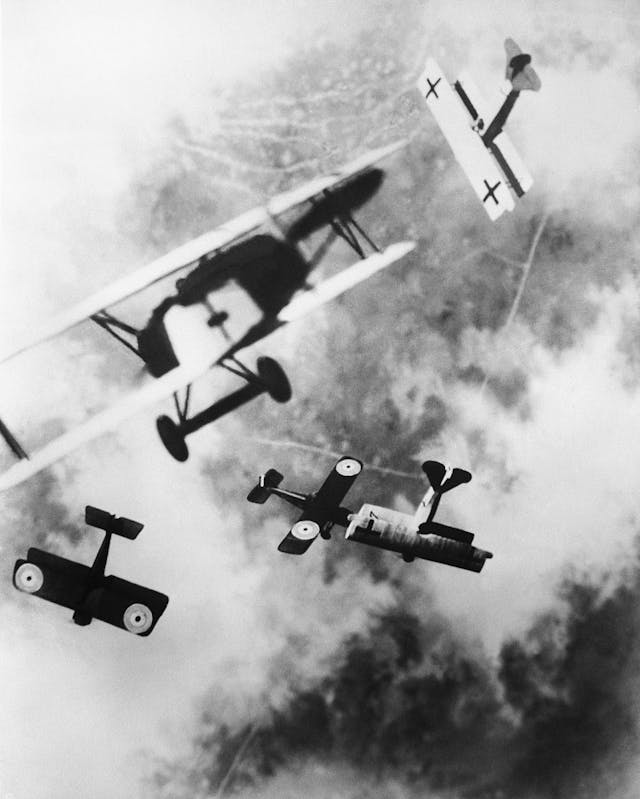
To be sure, winning a dogfight by saddling up behind my enemy and stitching their jet with bullets from stem to stern would be awesome, however, I prefer to shoot down my enemy’s aircraft from many, many miles away. For decades, the basics of dogfighting were the same: shoot at the enemy aircraft with a gun. First a pistol, later Fokker’s machine gun synchronized to not shoot its own propeller, then a cannon as technology evolved. It’s easier to do so when behind the enemy, but that’s certainly not a requirement. Heat seeking and radar guided missiles were first used by US forces during the Vietnam War, though they didn’t work particularly well. Helmet mounted cueing and high off-boresight missiles mean it’s hard to stay alive for long in a dogfight in the present day.
At its core, dogfighting is a delicate balance between instant and delayed gratification. Some of the factors affecting the gratification timeline include my aircraft’s performance (both sustained and edge of the envelope limits), my enemy’s aircraft performance, weapons carried and state (am I fully loaded or nearly spent), fuel state, overall threat environment, and mutual support (are there friendly aircraft supporting me in my fight). If my aircraft and I clearly outclass my enemy, I can afford to be a bit more patient. If it’s close to an equal fight or my fuel/weapon state is critical, I want to kill them quick and get out of Dodge ASAP.
As taught at the undergraduate school of dogfighting, there are two kinds of fights: rate and radius.
In a rate fight I’m concerned about my turn rate (degrees per second) relative to my enemy; this is the delayed gratification fight. If I know I can out-rate my enemy, I’ll gain a few degrees of turn each second and over 30-60 seconds I’ll end up offensive (behind them) and shoot them down at my leisure (-ish, they don’t generally just wait to die in passive fashion). Fighting a jet that can out-rate you is like being tied to the road and watching a steamroller slowly approach to run you over; you know you’re going to die, but it takes forever to actually die and you’re essentially powerless to do anything about it.
On the other hand, in a radius fight it’s all about flying a smaller circle in the sky than the enemy. With a smaller radius I’ll turn inside them, quickly gain the offensive, and kill them. This is the instant gratification fight. As radius is determined by a few factors, notably airspeed and g, rate fights are generally more brutal and are flown at very high levels of G forces (to be fair, turn rate is also determined by airspeed and g – and other variables – but the mathematical formulas that calculate rate and radius have airspeed and G in different locations and with different exponents so they are affected differently by the same factors). Radius fights also typically end quickly; rather than sustaining energy (airspeed and altitude) like in a rate fight, I’ll “cash it in” and trade my airspeed for a smaller radius to rapidly achieve a position from which I can employ ordnance. Fighting a jet with a significantly smaller turning radius is like having your car’s engine explode when the light turns green at a drag race; you’re not sure what happened, but it was over quick and man, did it hurt!
A radius fight can transition to a rate fight, but it’s tougher for the opposite to occur. The decision a pilot faces each moment in a dogfight is whether or not to “cash it in” and go for the kill, or continue to fight patiently and wait for the right moment.
Future time orientation, and our propensity to be so oriented or not, is a lot like dogfighting. Do we save for a rainy day, eat kale salads, and go to bed at a sensible time each night (future time oriented), or spend money like a drunken sailor, consume the fighter pilot standard of Snickers and Coke for lunch, and live for the moment (not future time oriented)? Much like the cash-it-in-now-or-wait-until-later energy decision I’m continually making in a dogfight, we do the same in life. Do I stay up late tonight or not? Do I eat that extra piece of cake? I should go to the gym. Ascetic or gluttonous life? Hmmm, turns out that I can sell my paid-off 2016 Miata GT six-speed for slightly more than I paid for it 4.5 years and 19,000 miles ago. Should I sell it and get a 2022 Miata? Instant or delayed gratification?
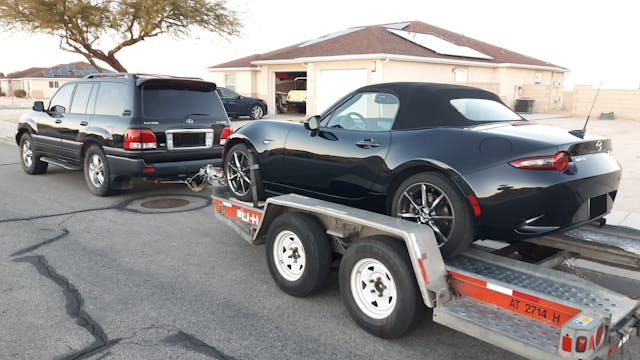
My friend’s farmer dad used to say, “If you don’t want to do something, any excuse will do.” I also think the opposite is also true, “If you want to do something, any excuse will do.” The struggle, as they say, is real. It’s perhaps most apparent with money, wherein the desire to have sufficient saved for the future means we have to be REALLY good at saying no lots and lots of times. When I put on my dad hat and talk to my kids about money, I stress if they want to buy big things, like a car or a house, they can’t buy froufrou trinkets and junk or have ten different streaming services — and they should get off my lawn while they’re at it!
I get it, you’re not here for financial advice and I’m certainly not the person to dispense it. But when I realized what I could get for our 2016 Miata I started making puppy dog eyes at my wife and telling her we could get a new Miata for almost no money (ish)! The fact that our Miata had ~20,000 miles on it (it had 1,000 when we bought it), plus it looked and ran great, didn’t matter anymore. And yet, we gotta stay in the financial rate fight and make slow progress to get to where “future us” wants to be. The day will (hopefully) come when each and every one of us can switch to a radius financial fight and literally cash it in, but when is that day? Could it be today? Why isn’t it today?
Eight days ago I was messing around on Mazda’s website and built a 2022 Miata GT six-speed in polymetal gray with a terracotta leather interior. I put in my zip code to check availability nearby. Zero. I put in a city 225 miles away. Also zero. On a whim I put in my in-laws’ zip code. One available. In stunned disbelief I went to that dealer’s website and sure enough, there it was. I blurted out as much to my wife and proceeded to email the dealer to see if it was still available. It was. That’s when the discussions started in earnest.
My wife and I spent the next several days discussing all sides of the purchase. It was frivolous because we didn’t need it, it wasn’t free (free would have been the base Sport model, or essentially so, not the GT), and the responsible thing to do was save. It made sense because it was shiny and new. And had 30 more horsepower. We each took both sides as we changed our minds back and forth and they were great discussions. The end result was a stalemate between the financial rate and radius fights. We were fortunate it wouldn’t really hurt financially, but we didn’t need to do it. Which is why we did it.
As we were having our conversations, I was emailing/texting with the dealer on cost (MSRP minus $500 loyalty and $500 military discounts; no dealer markup!), what our trade might be worth, and how to purchase a vehicle in one state while living in another and registering them in yet a third (totally legal as an active duty military member). Finally, the time came to poop or get off the pot, so we told them we were in and put down a deposit.
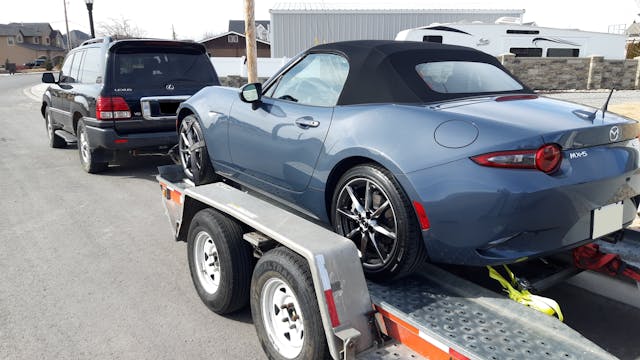
I opted to tow the Miatas instead of driving them back and forth for a couple reasons. First, driving 500+ miles in a Miata in a single day, on back to back days, didn’t sound fun. Second, I wanted to keep the miles low on the trade-in and not put a ton of miles on the brand new one unnecessarily. It certainly cost more in gas and trailer rental, but the Lexus eats up miles both on and off-road, so it was all good.
And so it was that I found myself driving in close formation with a tire bouncing down the freeway, grateful it was running parallel to me, wondering if it came off of my trailer, and hoping it hadn’t damaged the car I was about to trade in. After assessing it wasn’t going to hit me and I was outpacing it, I looked ahead and saw an SUV towing a camping trailer that was missing a tire and pulling over. As I cruised past them, I was glad to see the trailer had two axles so they weren’t dragging a shower of sparks behind them (that’s a story for another day).
Frustratingly, even though I conveyed to the dealer that I had a ten hour drive home and needed the paperwork to go quickly (I sent them everything they would need to have all of the paperwork ready to go, but it hadn’t even been started), it still took almost 2.5 hours and I was easily the first buyer in the door that day. My favorite part was when the finance person asked if I wanted GAP insurance. I asked if I really needed to worry about the Miata losing $25,000 in value when I drove off the lot. I was told that would not be the case “in today’s market.” SMH. We took advantage of their 0.9% interest rate for 36 months, so we’ll be paying about $11 per day, of which less than twenty cents is interest, for the next three years. Totally and easily justifiable!

On my drive home I called our 20 year-old daughter. She asked what I was up to and I told her I was towing a new Miata home. Surprised we had exchanged one Miata for another, she asked what the difference was between the two. I told her they were roughly 92.4% the same. The new one was a different color on the outside and inside, some of the gauges were different, the new one didn’t have a CD player, but it did have 30 more horsepower. She busted up laughing and expressed incredulity that we were spending some $10,000 for 30 horsepower because everything else was essentially the same between the cars. I’ll admit I was a little surprised this was coming from the child who once had a mason jar labeled “Astro Van Fund” and asked if getting a loan for $6,000 to buy a 1996 Astro Van with 200,000 miles was a good idea. Good thing I love her guts! She totally changed her mind and fully supported the purchase when she saw photos of the Miata, by the way.
Thankfully, while it may feel like it at times, life doesn’t imitate dogfighting. To wit, the rate vs radius financial fight isn’t necessarily an either/or proposition. To be sure, our ability to choose our financial battles varies greatly person to person, but can be possible to both be future time oriented while still enjoying the present. Thus, I’m confident I didn’t commit financial fratricide on the family finances by purchasing the Miata. Frankly, when I look at it, sit in it, start it, and feel that extra 30 horsepower, I almost don’t care if I did!
